The Case for Displacement-Speed Yachts
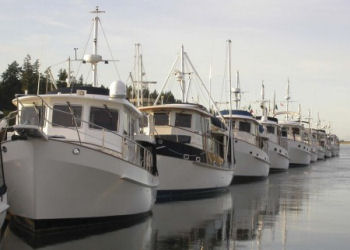
Row of Kadey-Krogens in La Conner, WA during a rendezvous. Born during the last fuel crisis 30 years ago, Kadey-Krogens are the concept of the hour.
Speed has always been a hallmark of power boating, even in the early days. In 1893, Chris Smith pushed a clumsy looking rowboat out on the St. Clair River with a gasoline engine in it, the first one on the Great Lakes. It went nine miles an hour and was the fastest boat around. By 1911 Smith was building raceboats, funded by a millionaire sportsman, and breaking speed records in the 80 mph range. In October 1906, Alexander Graham Bell said, "I consider the invention of the hydroplane as the most significant of recent years." A few years later he was testing his own twin-engine hydroplane on the Bras d'Or Lakes in Nova Scotia and was setting speed records. 
Gar Wood set a speed record of 124 mph in 1932 in this Packard-engine powered raceboat.
“Slow” is “Counter-Intuitive”
By definition, boaters are sportsmen whether they cruise or fish or wakeboard. And sportsmen, by definition, always want to go fast. So what we are talking about now is “counter-intuitive” for virtually all boaters.
It takes real discipline and possibly a completely different mind-set to get used to – and actually enjoy – going slow. But it is possible. Just look at all of the blow boaters in the world. They talk about going “fast” at 7 knots! Speed is a relative term as all sailors well know.
So as unpleasant as it is for most power boaters to contemplate adopting a rag boater speed mentality, let's consider it an intellectual exercise, if nothing else. 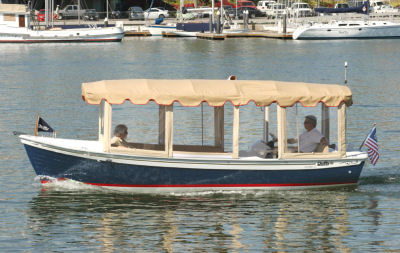
This Duffy 23 electric boat has its virtues.
The Laws of Mother Nature
The “hull speed” of a boat (power or sail) is 1.35 x the square root of the waterline length. That means if the waterline length (LWL) of your boat is 40 feet, its hull speed is 8.5 knots (40/sq. root = 6.3245 x 1.35 = 8.54), or 9.8 mph (8.54 x 1.15). In order to go faster than that, you will need to apply enough horsepower to get the boat up and over its own bow wave onto a planing or semi-planing mode.
So, if you want to defy the laws of mother nature, be prepared to pay for it.
This is why “commuter” powerboats back in the 1920s were long and narrow. By putting the boats’ structure and weight into length rather than beam they could simply go faster for a given horsepower.
Déjà Vu All Over Again
Since the first Middle East oil embargo of the U.S. in 1973, power boating has been assaulted several times by supply and price. In the dark days of the ’73 embargo there were those in Congress calling for a complete shut-off of fuel to the recreational marine industry. Thankfully, the GAO did some research and discovered that boaters’ annual use of fuel was so low in total, that it was insignificant in the big picture.
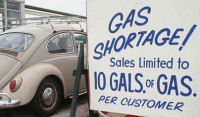 |
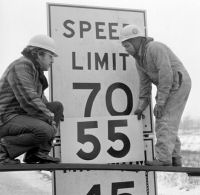 |
Nevertheless, short supply affected price. Not surprisingly, a number of “trawler-speed” boat builders sprouted up or became stronger during the turbulent ‘70s. Grand Banks became more popular and a dozen brands of “trawlers” imported from Taiwan met the demand for economical, yet roomy cruising boats. In the U.S. companies such as Kadey-Krogen, Nordhavn, and others, were founded on the notion of long-distance affordable cruising. Hatteras, which was the world leader in flushdeck motoryachts at the time, even introduced a line of displacement yachts called LRC (Long Range Cruisers). Three-time Bermuda Race winner Carleton Mitchell – who at the time was probably America’s premier yachtsman – bought a Hatteras LRC and cruised widely from his Key Biscayne, FL home. If "Mitch" would do it, it must be a good idea. 
A Hatteras LRC idles down the ICW burning little fuel. They are still popular on the used boat market.
But the Hatteras LRCs were built for only 10 years before being discontinued for lack of sales. (Today they sell for a premium to other motoryachts of their vintage on the used boat market.) When the oil faucet was turned on again and a global slowdown took hold, fuel prices declined and powerboaters put the pedal to the metal once again. 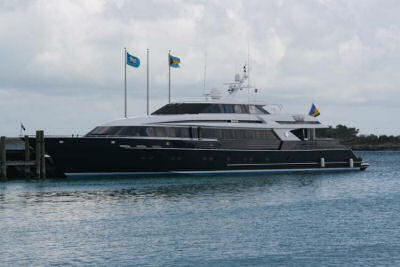
Octopussy is the megayacht that started the quest for speed in large motoryachts in the mid-1980s.
Indeed, in the mid-1980s Long Island car dealer John Stalupi built the megayacht Octopussy that went over 50 knots and the quest for speed was on again. In the 1990s European motoryacht builders Azimut and Ferretti built large production motoryachts weighing as much as 200,000 lbs. that could go over 30 knots.
As of last year, buyers of large production motoryachts wanted to go over 30 knots, convertible buyers wanted to go over 40 knots, and many express cruiser buyers wanted to go over 50 knots. 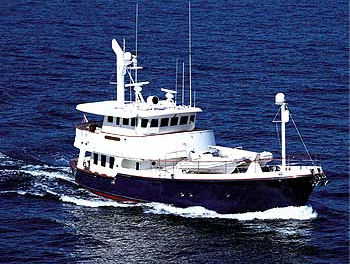
The Nordhavn 62 has become the poster child for fuel-efficient “expedition” yachts.
Planing Hulls at Displacement Speeds
Nowhere is it written that one is prohibited from going hull speed in a planing or semi-displacement boat. In fact, by doing so, a boat owner can reap many of the rewards of fuel economy enjoyed by trawler yachts and long range cruisers with single engines or small twins.
Obviously, planing boats with big engines are not as fuel efficient as trawlers with small engines at displacement speeds, but huge economies are to be had nonetheless. To find out what this might actually mean, we took a look at our own database of boat tests. Miles Per Gallon (mpg) is the key number. Here’s typically what we found--
- *A 58’ Kadey-Krogen (96,830 lbs. Powered by 2x154-hp John Deere Diesels): 1500 rpm, 9.0 mph, 2.37 mpg.
-
*A 50’ Nordhavn (55,932 lbs. Powered by 1x250-hp Lugger Diesel): 1500 rpm, 8.0 mph, 2.05 mpg.)
Slow Down and Smell the Daisies
There is a lot to be said for going slow.
First, one can actually enjoy the scenery and the surroundings rather than having to keep one’s eyes riveted forward making sure to avoid a deadhead or some other obstruction, to say nothing of other boats.
Second, it is a lot quieter. Engines make noise and usually they are pretty loud toward the top of the rpm range. It’s nice to be able to talk to the other people in the boat without yelling.
Third, it's a lot safer. Most boating accidents occur at high speed and many of those are at night. It should go without saying, that one MUST ALWAYS travel at displacement speeds at night.
Fourth, it is a lot easier on your boat. Boat builders work hard to manufacture boats that can be bashed through seas at speeds that are sheer lunacy, but nevertheless such activity often takes a toll on the boat and its components. Displacement speeds will pamper your boat just the way you probably baby your automobile.
Finally, you will save money in fuel. By carefully planning your boat’s usage, distances and speeds, you can easily manage your boat’s operation on a budget. And, who knows, someday the U.S. government might get an energy policy and fuel prices may drop with a strong dollar. Enjoy your summer!